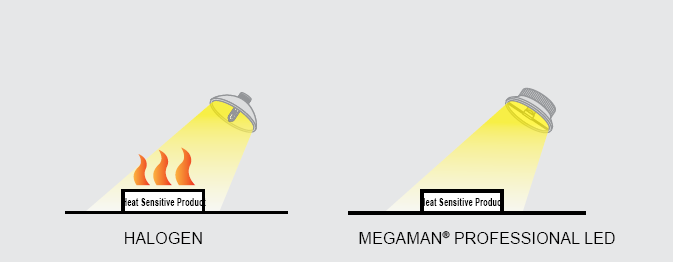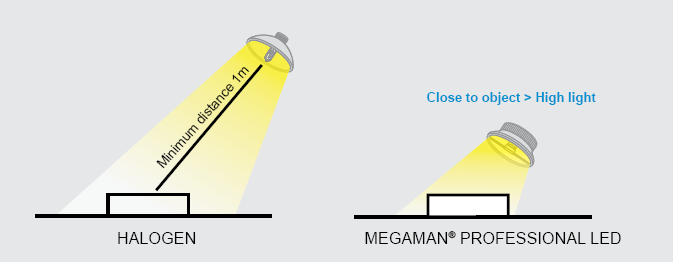Temperature
To maximise the reliability and performance of LEDs, proper thermal management is essential. If the LED's maximum operating temperature is exceeded, light output drops and lumen maintenance decreases andas such the useful lamp life is shortened. Therefore it is essential that validation of an LED's temperature is undertaken by means of temperature measurements to ensure optimum performance.
In general, manufacturers define an LED's maximum operating temperature at the semiconductor level (Tj = T junction). To ensure this limit is not exceeded, temperature measurements are necessary. Although the critical temperature to measure is the junction temperature Tj, the inaccessibility of this point has led to the creation of an additional measurement – the Tc temperature. There can also be a designated Tp point (performance) where more than one value of Tp is allowed if it affects the lifetime and performance claim.
This separate Tc or Tp temperature measurement point is chosen as such that it has a direct relation to the Tj junction temperature and must not exceed the specified limit. If the measurement of this Tc or Tp temperature is below or equal to the specified limit then the stated life and luminous flux of an LED will be achieved. Exceeding the limits set for Tc or Tp will negatively impact the initial product performance as well as its useful product life. All measurements must be performed by means of thermocouples that are correctly fixed to the Tc or Tp points. Where a Tp point has more than one value, if the lower one is exceeded then the next higher is regarded as the limit and the corresponding lifetime, performance claim applies.
The MEGAMAN® retrofit LED solutions have an integrated heat-sink to drain the heat away for the LED’s. When integrating such retrofit products into a luminaire a final temperature measurements at Tc point is advised to ensure that Tc,max is not exceeded when operated inside the luminaire. Unlike retrofit solutions the majority of LED modules and light engines placed on the market are not self- cooled and do not have an integrated heat-sink. Therefore cooling needs to be integrated in the luminaire by means of a heat-sink or thermally suitable fixture body. Again the thermal heat drain capacity of the system is to be validated by the Tc or Tp temperature measurement in reference to Tc,or Tp max. For LED modules and light engines additional thermal interface parameters (such as, but not limited to, max. thermal power at the thermal interface, max. thermal resistance of the luminaire) can be defined. These parameters can be used, for products designed in line with Zhaga specfications, to ensure interchangeability.
Thermal management
Temperature and its control have a significant impact on the quality and lifespan of an LED. To ensure LEDs operate at their optimum capabilities, effective thermal management is essential.
The principal role of thermal management is to extract the heat from the LED module and dissipate it into the surrounding air. This can be done through conduction, convection and radiation and different approaches are being taken to this issue across the industry, with varying degrees of success.
Optimum thermal management is achieved when the number of thermal conductive interfaces between the LED and its heat sink are reduced and the thermal resistance between these interfaces is minimized. In addition, careful consideration needs to be given to the heat sink material, its surface area, geometry and roughness as well as the management of airflow around the LED as a whole.
MEGAMAN®’s unique approach
MEGAMAN® has 3 different methods of controlling light but none involve the multiple lens arrays favoured by many manufacturers to direct light output since amongst other things these tend to trap heat, meaning a larger heat sink is required. MEGAMAN® uses; parabolic reflectors with dual axial LED and Thermal Conductive Highway™ (TCH) technology (see below), single LED plus optical reflectors for precise beam control where space is limited or simply LED plus prismatic controller for basic halogen equivalents. All of these methods allow better thermal management, smaller heat sinks and true size retrofit profiles across the whole lamp range.
Thermal Conductive Highway™
MEGAMAN®’s patented Thermal Conductive Highway™ technology uses a unique design of ‘heat drain’ across the reflector to dissipate heat efficiently from the dual axial LED to prevent deterioration of the chips and other components. The technology also gives the lamps a longer life.
Thanks to careful thermal management, MEGAMAN®'s LED lamps all combine the higher efficiency, lifetime, and reliability benefits of LEDs, with comparable output levels of many conventional light sources at only a fraction of their power consumption.
New display opportunities
With MEGAMAN®’s advanced thermal management technology, all of its LEDs can be positioned in areas not traditionally possible with hotter halogen equivalents. MEGAMAN® lamps can be placed close to the objects they are lighting, with no risk of heat, UV or IR degradation. This makes them ideal for sensitive display areas, such as food halls, museums or galleries. MEGAMAN® light sources can also be located in access areas close to the general public, with comparable output levels of many conventional light sources at only a fraction of their power consumption.
 Diagram 1: Heat from Halogen Lamp versus LED in related to Heat Sensitive Products
Diagram 1: Heat from Halogen Lamp versus LED in related to Heat Sensitive Products Diagram 2: Heat from Halogen Lamp versus LED in related to distance from lit products
Diagram 2: Heat from Halogen Lamp versus LED in related to distance from lit products

 top
top